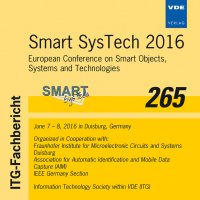Extended Discussion on Non-Identical Planar Resonant Coils for Frequency Splitting Elimination in Wireless Power Transfer Systems
Konferenz: Smart SysTech 2016 - European Conference on Smart Objects, Systems and Technologies
07.07.2016 - 08.07.2016 in Duisburg, Germany
Tagungsband: Smart SysTech 2016
Seiten: 11Sprache: EnglischTyp: PDF
Persönliche VDE-Mitglieder erhalten auf diesen Artikel 10% Rabatt
Autoren:
Schmidt, Christian; Buchholz, Martin (School of Engineering, University of Applied Sciences, Saarbrücken, Germany)
Inhalt:
Frequency splitting is a well known phenomenon in coupled resonator structures. Along with the increased research on wireless power transfer (WPT) systems through inductively coupled resonators, this phenomenon has been identified as drawback for systems capable of transferring energy efficiently over varying distances. The shifting resonant frequencies of inductively coupled resonators subsequently cause the passband of such a system to shift, leading to a single transfer distance with maximum efficiency depending on the system design. Techniques to handle this behaviour have been published but all of them need additional control loops thus increasing complexity. A technique to avoid the system behaviour described before by using resonant coils of non-identical radius (non-identical resonant coils, NIRCs) has just been published. Based on these findings, further analysis is performed in this paper. Furthermore, the impact on the most important coil parameters is studied and drawbacks regarding the overall system performance are highlighted. Special coil designs are introduced to stabilize the system behaviour despite using non-identical coils and thus avoiding frequency splitting. In the experimental verification, good agreement with the theory is found, as frequency splitting is eliminated. Nevertheless, a certain frequency shift of the single resonant mode is observed. The analysis presented provides a wide range of optimisation dependant on geometric design parameters and is applicable to resonant WPT as well as Radio Frequency Identification and Near Field Communication (NFC) systems.


